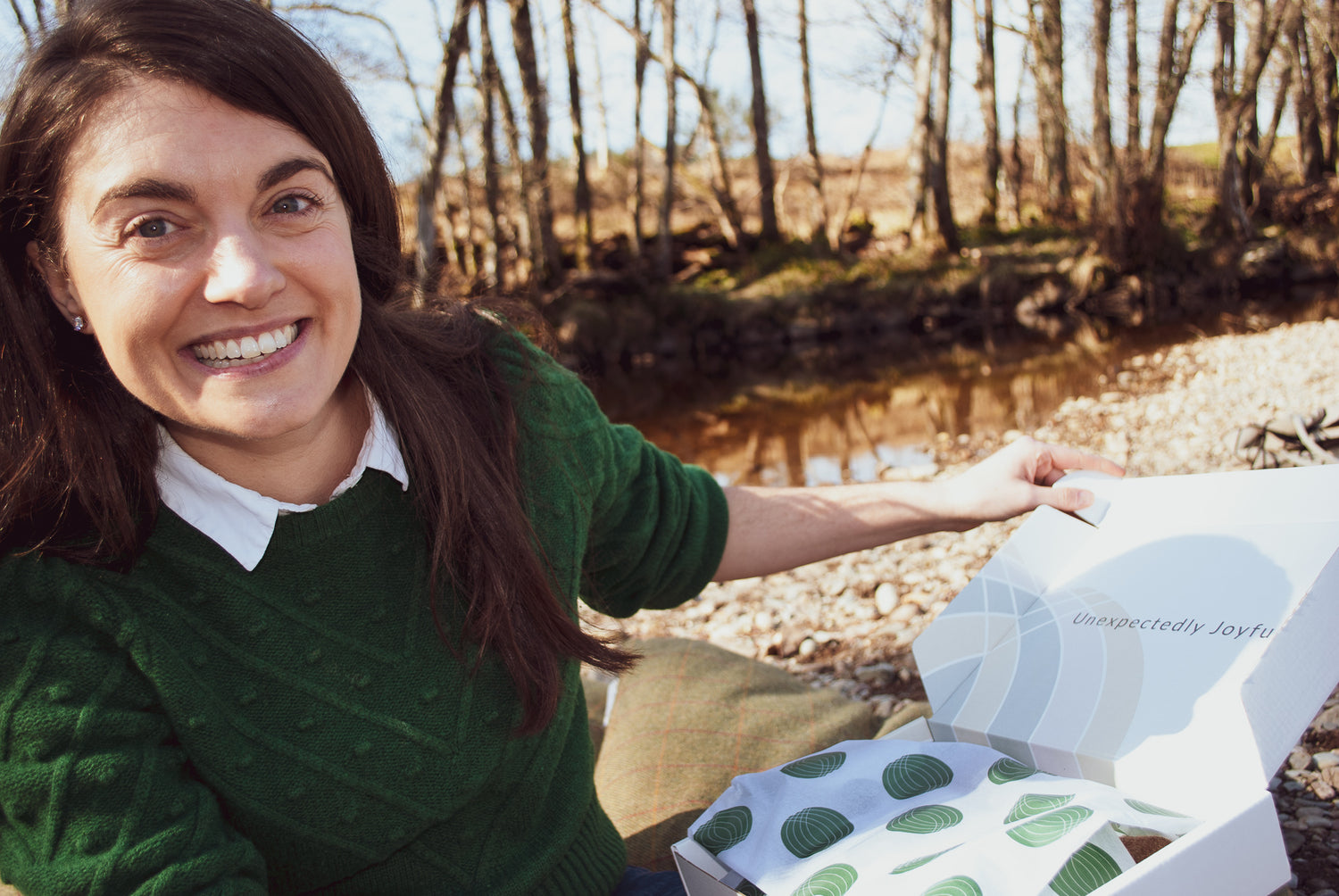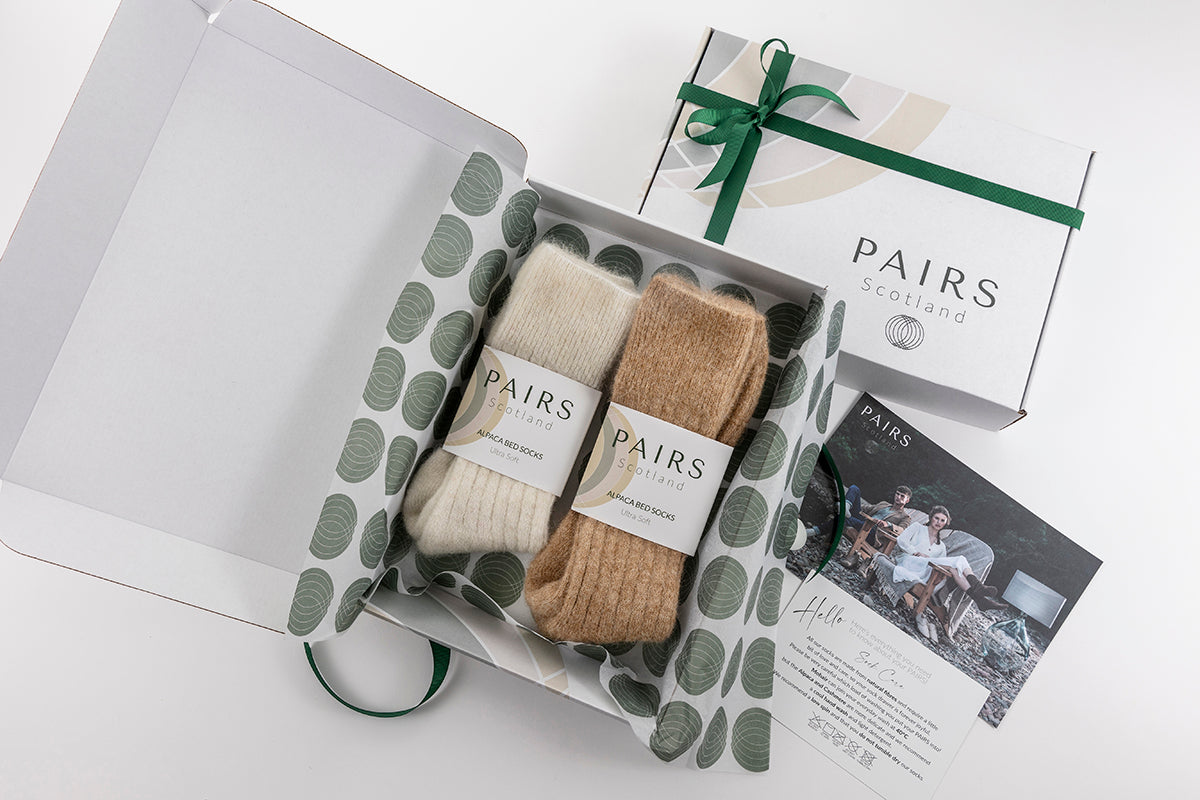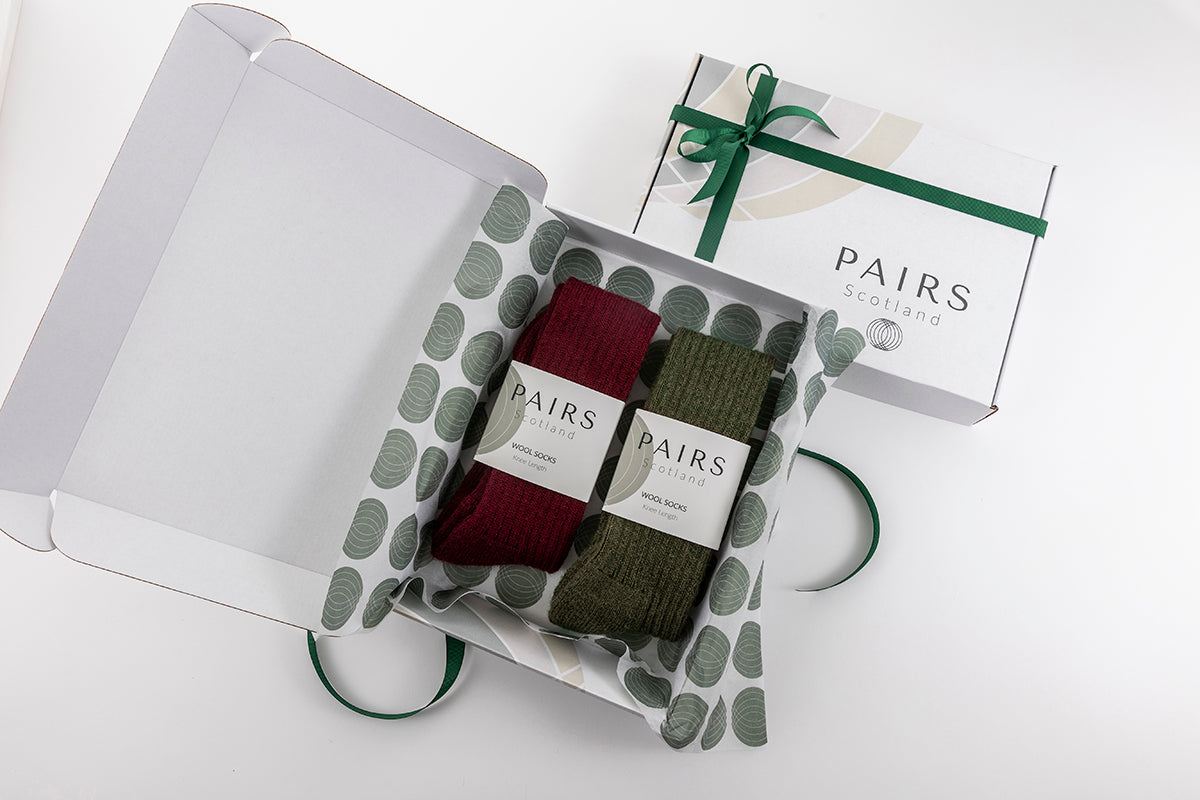Socks are entwined into our everyday lives and as a result the global socks market is mind bogglingly huge. There are over 20 billion socks produced every year. But are these the right kind of socks and do we really need so many going into production and conversely into landfill each year?
When Alice and I started our PAIRS journey back in early 2020 we knew that we couldn’t shift the entire fashion industry’s attitude to waste and dubious material usage but what we could do is create our own unique home for unexpectedly joyful socks that used natural materials from sustainable farms in their native countries creating a brand that really promotes buy better, buy less ethos, while supporting indigenous communities and British manufacturing.
Our sustainability journey is only just beginning but we are proud that we have been able to created solid foundations right from the outset. We want our actions and practises to speak volumes not use marketing techniques to green wash. Customers deserve transparent conversations with brands and so we hope the following article answers lots of questions about our vision and decisions thus far in our quest to create a sustainable company.
Contents
- What does sustainably mean to Pairs Scotland?
- Where do Pairs Scotland source their fibres from and are they sustainable?
- How does a circular economy play into Pairs Scotland’s vision?
- Why does Pairs Scotland champion regenerative agriculture?
- Is it harmful to shear animals for their wool?
TO BE CONTINUED…. Part 2 coming soon
- Will Pairs Scotland start use cotton to make socks?
- Why does Pairs Scotland use nylon in their socks?
- How do you choose the best sock for different activities?
- Why has Pairs Scotland chosen to make 99% of their socks in the UK?
- How do you make sure your Pairs Scotland socks don’t get sent to landfill?
What does sustainably mean to Pairs Scotland?
There are three main factors that dictate if a product or a company is sustainable and at PAIRS we are working hard to holistically create a business and brand that hits these targets consistently while also evolving and improving them at every step.
What are the three drivers to sustainability then? They are economic, social and environmental.
For us the economics have to work for all parties involved in the supply chain. It has to be profitable or there is no business and any part of the supply chain collapses and leaves others within it without a customer. There is a fallacy out there that either people shouldn’t make a profit or all brands are evil corporations creaming off vast profits at the expense of their supply chain. In our case this is certainly not the case! At the moment everyone in the world needs to make a living, whether you are living in the UK or in the peruvian mountains and we want to ensure that everyone in our chain has a fair deal.
The social aspect is that through our business we can continue to provide fair jobs for those involved in our supply chain. Pairs Scotland is as far away from a fast fashion brand that you can get and it's important to us that the working conditions are positive and everyone receives a fair pay for a fair day’s work.
Finally the environmental impact must not risk over stepping the delicate balance of natural resources and producing a product for market. The global textile market has a long way to go, particularly in the fast fashion industry. Our vision for PAIRS is that we must endeavour to positively impact the soil, climate, biodiversity and water system as much as possible and build on this at every step.
Where do Pairs Scotland source their fibres from and are they sustainable?
MOHAIR
Our mohair socks are our hero product and the reason behind launching Pairs Scotland. Mohair is an incredible fibre and absolutely speaks to our vision to tread carefully on the environment, move away from disposable fast fashion items and have a positive economic and social impact for the farmers and our British craftspeople at the mill.
Mohair South Africa (MSA) is a non-profit organisation that acts as the mohair industry’s regulating body to ensure responsible and ethical production of the fibre. South Africa provides a prime environment for the angora goats, who thrive in the Karoo region, which has a very hot and dry climate in the summer but very cold in the winter meaning the fibre is uniquely adapted to being very robust and temperature controlling.
What is important to us is that the fibres we use are traceable. Mohair South African is a member of the Textile Exchange, is a global non-profit that works closely with its members to drive industry transformation towards better integrity, standards and responsible supply networks (https://textileexchange.org/about-us/).
MSA has implemented a comprehensive traceability system, which means that our yarn supplier can track the exact origin of the mohair used in every item containing the natural fibre. MSA also have a programme of continued assessment of angora goat farms. Assessment, and obtaining a satisfactory rating is necessary for marketing mohair, and producers' rating will be readily available and is reflected in respect of the mohair sold at sales. Thus enabling every purchaser of mohair to ensure that it has been ethically produced.
ALPACA
90% of the world’s alpaca population is based in the Peru and the cosmovision that anchors their place in the 120,000 Peruvian families who depend on them is so woven into the fabric of the animals’ wellbeing, it is fundamental to not only the people’s survival and culture but the alpacas themselves.
Not only are our fibres from Incatops a member of the Textile Exchange but they have also created their own body for traceability. Dealing is direct, without the participation of any intermediary. This enables a relationship of trust to be forged between the alpaca producer and Pacomarca through the provision of technical support which improves production and generates an enhanced income for the farmer (https://www.incatops.com/en/news/incatops-traceable-alpaca/).
For more than 5,000 years, countless generations of people have devoted their lives to this noble activity of caring for and using the by-product of the fibres from the alpacas. This is the greatest example of sustainability!
Lambswool
Our lambswool bedsocks were developed in conjunction with our Turkish Mill and the wool is sourced in turkey as well. This reduces the carbon footprint in the supply chain. All the fibre used is graded by OEKO-TEX which enable consumers and companies to make informed decisions which in turn protect our planet. The testing and certification process guarantees maximum consumer safety.
How does a circular economy play into Pairs Scotland’s vision?
We know that we can’t shift the fast fashion system alone but we can be part of the change. We want to muster an ethos of transparency, and traceability, while inspiring change in our consumers attitudes to waste and disposable fashion.
The key elements of a circular fashion economy are:
- Keep clothes for longer
- Use sustainable fibres
- Produce fibres that can be used again
We have a very strong point of view that we should all be buying less but buying better. This allows us all to buy and wear garments, such as PAIRS socks, that we know are not going to get holey after a few months. When the day comes, far into the future, that your socks look a bit worn you can repair them easily yourself at home. I feel a darning lesson coming up!
Another interesting stance is the cost per wear. How many times are you going to wear our socks? Well lots we would imagine, as not only are they robust and hard wearing but you can wear the same pair for many days in a row due to their very special anti-bacterial properties so they do not smell. Another bonus for less water usage.
Talking of water, while our mohair socks can be washed at 40 degrees why not turn down your washing machine temperature to 30 degrees and you’ll not only be helping your energy usage and the environment as a whole but your socks will thank you for it as well.
When it comes to positive environmental action one of the best things consumers can do is choose garments made from sustainable fibres. In the above section you are read all about the the sustainability of our fibres. According to The Waste and Resources Action Programme (WRAP) around £140million worth of clothing goes to landfill every year. So do the planet a favour and choose your fashion wisely.
So the questions to ask yourself are these:
- Is the company and brand I am choosing to buy from have a transparent traceability procedure?
- Does it align with my social, environmental and economic views for me, my community and those on the planet.
- Has everyone in the creation of this product been given a safe and fair working environment and pay?
- Is the company making a sustained effort to reduce their environment impact, be it through water usage and carbon usage?
- Will the product last, be repaired and not be sent to landfill?
Why does Pairs Scotland champion regenerative agriculture?
Regenerative agriculture/farming means to close the nutrients loop, to preserve and regenerate the soil and to minimise environmental impact. If practised, we can reduce land-use, chemical fertillisers, resource requirements and our ecological footprint. This is not a new concept. It was the norm pre industrialisation, but has been pushed aside by intense farming practises and mono-culture crops which focus on maximising profits over environmental protection.
“The integration of mixed crop-livestock and organic farming, agroforestry and water recycling and wastewater reuse, is a key element of a circular agriculture model that aims to reduce CO2 emissions, use natural resources more efficiently, and cut the use of inputs significantly”. (https://www.un.org/development/desa/dpad/publication/un-desa-policy-brief-105-circular-agriculture-for-sustainable-rural-development/)
Regenerative farming is environmental sustainability personified. It means good stewardship of the natural systems and resources that farms rely on. The following sources are from The Union of Concerned Scientists and echoes our beliefs. This includes:
- Building healthy soil and preventing erosion
- Managing water wisely
- Minimizing air and water pollution
- Storing carbon on farms
- Increasing resilience to extreme weather
- Promoting biodiversity
Regenerative agriculture is farming in sustainable ways to meet society's present food and textile needs, without compromising future generations to meet these needs. It can be based on an understanding of a complete and harmonious ecosystem.
Why do we need animals for this? Isn’t it cruel to keep animals on a farm?
It all comes down to soil health. Healthy living soil, teeming with live organisims, promotes healthy crops, prevents pollutions, holds water and allows the farmers, their communities and us to thrive. A growing body of evidence shows that a smart integration of crop and animal production can make farms more efficient, healthy and profitable. Our current farming system in the UK tends to keep plant and animal production separate, with animals living far from the areas where their feed is produced, and crops growing far away from abundant manure fertilisers. This is one of the reasons we work with ingenious communities in South Africa and Peru as their farming practises with their animals are more organic and holistic for the the animals and the soil.
Wherever nature can be mimicked you will find a thriving environment, so when it comes to agriculture, the most sustainable and productive systems are more diverse and complex.
Let’s take the example of an alpaca. It looks after the land it lives on and its breeder looks after the beloved animal it guards. So it is only right that we, as consumers, should treasure and value anything made from this sustainable animal. The alpacas live on quite poor terrain in the mountains and their cushioned paws are perfect for being gentle on the soil as they pluck their plant food, they play a intrical role in maintaining the balance of this ecosystem. They fertilise the soil as they move freely, the soil is given vital nutrients, plants grow as a result, they help secure water into the land and alpaca and the community has food to eat. The natural by-product of it’s fibres are shrawn off for the health of the animal and the farmer is able to sell this product to support himself. A natural cycle that benefits all.
How about over in South Africa? The angora goats, and the rangelands on which they roam, have provided farmers with a relationship delicately woven together and reliant on each other for life.
“In support of the UN’s Decade of Restoration, it’s time to embrace the journey of land regeneration. This will enable and increase the productive capability of our farming efforts and land over several decades, making regeneration a journey of growth. In some way, every South African farmer has implemented environmental management practices on their land by the mere nature of farming in the country. This could be through the restoration of degraded landscapes by changing herding practices, re-establishing vegetation, or excluding animals from certain camps for periods. Rather than something totally new, regenerative action is a further development of current management with a mindset of continual improvement”. (https://www.mohair.co.za/mohair-blog/the-future-of-responsible-mohair-farming-in-south-africa)
Is it harmful to shear animals for their wool?
No.
It is absolutely not cruel to shear animals. It is a necessity for their health and well-being.
We understand that individuals and groups such a PETA follow a vegan lifestyle and we respect that, just as we would like that respect returned to us and any of our customers who are not. We hope that this rather huge document discusses in detail why we stand by our own personal choices.
We absolutely abhor animal cruelty and take great efforts to source our fibres from reputable merchants with traceability schemes.
No farmer goes into rearing and raising animals with express intent of harming them. I have lived in rural Scotland my entire life and am very lucky to be surrounded with wide open pastures and rugged hills where sheep and cattle graze. I know many many farmers and even some that carry homeopathic remedies to support in their livestocks’ health. Famers that sit up all night during lambing and calving to ensure the safe and stress-free delivery to the new mothers is the norm and some, even, reiki their animals before they are loaded for market and beyond.
We know that this is not the case 100% of the time. It is a sad sad truth and every attempt should be made to regulate and educate farmers in positive animal welfare. But the media can not be allowed manipulate consumers into thinking this is the norm and all livestock farmers are cruel, profit hunters.
In Peru, where are alpaca fibre comes from, shearing practises have strict protocol and have improved immeasurably over the past decade through the introduction of Inca Shearing, where the animal is treated with care, hygiene and less stressful conditions. Shearing the extremely fine alpaca fibre is a must every two years and the manufacture of this fibre provides thousands of jobs. I refer back to my points above on sustainability and circular economy. Imagine if this precious fibre was sent to landfill. Imagine if these communities weren’t paid a fair pay for their work looking after an animal that means so much to their culture.
In South Africa the mohair industry has developed a traceability system so every bit of fibre can be traced back to the farms. They have also created various assessments and farm visits to see that they are upheld along with using certified shearers who practise NWGA shearing. With this practise goats, among other things, are handled carefully, not exposed to undue weather conditions and are returned to food and water as soon as they are sheared. Any grazes are immediately cleaned, disinfected and given fly repellent oil to prevent infection.
An overgrown fleece on any animal is cruel. It can cause them a great deal of distress, discomfort, illness and skin problems. When sheared correctly it should only take a few minutes, cause no distress and relieve them of a heavy, thick coat over the summer.





